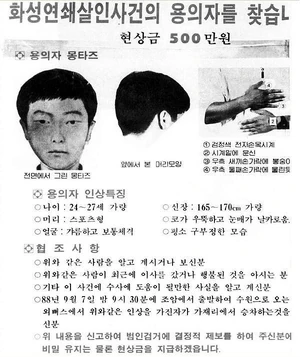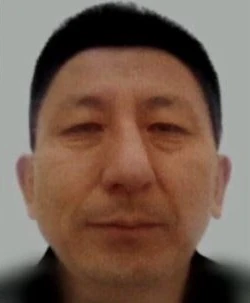No edit summary Tag: Visual edit |
mNo edit summary Tag: Visual edit |
||
| Line 72: | Line 72: | ||
==On Criminal Minds== |
==On Criminal Minds== |
||
*[[Season Seven]] |
*[[Season Seven]] |
||
| − | **"[[Unknown Subject]]" - While Lee was never directly mentioned or referenced on the show, he appears to have been an inspiration for [[Hamilton Bartholomew]] - Both were murderous serial rapists who targeted women of varying ages (though Lee also killed girls), were classed as anger-excitation and power-assertive rapists, had forensic countermeasures that involved wearing masks and other clothes, killed at least one victim by ligature strangulation after raping her, had signatures involving using a specific kind of binding on their victims (Bartholomew bound his victims with piano wiring, while Lee used his victims' own clothes), and were both given nicknames for their crimes. Also the way Yoon Sang-yeo was charged with killing one of Lee's victims and being deemed a copycat is somewhat similar to how [[Herman Scobie]] copycatted Bartholomew. |
+ | **"[[Unknown Subject]]" - While Lee was never directly mentioned or referenced on the show, he appears to have been an inspiration for [[Hamilton Bartholomew]] - Both were murderous serial rapists who targeted women of varying ages (though Lee also killed girls), were classed as anger-excitation and power-assertive rapists, had forensic countermeasures that involved wearing masks and other clothes, killed at least one victim by ligature strangulation after raping her, had signatures involving using a specific kind of binding on their victims (Bartholomew bound his victims with piano wiring, while Lee used his victims' own clothes), and were both given nicknames for their crimes. Also, the way Yoon Sang-yeo was charged with killing one of Lee's victims and being deemed a copycat is somewhat similar to how [[Herman Scobie]] copycatted Bartholomew. |
==Notes== |
==Notes== |
||
Revision as of 04:23, 12 July 2020
Lee Choon-jae, a.k.a. The Hwaseong Serial Killer, is a South Korean serial killer who was convicted of murdering his sister-in-law in 1994. In 2019, he confessed to fifteen other killings, including ten in the Hwaseong serial murders between 1986 and 1991. He also said that he had raped over 30 women.
Background
Lee was born on January 31, 1963 in Hwaseong, Gyeonggi, where he lived for 30 years. At some point in his life, his sister drowned and he was greatly affected by her death. He claimed to have been sexually assaulted by an older sibling, which may have led to the sexual nature of his killings; however, there is no evidence to confirm this actually happened.
After graduating from high school in February 1983, Lee joined the Republic of Korea army and served as a tank pilot; he was discharged on January 23, 1986. He then worked for an electric parts company. In 1990, he began his job at a parent construction company in Cheongpa, Yongsan District, where he became a fork lane driver without a license. The following year, he was a forkrain driver for an aggregate company in Cheongwon, Chungcheongbuk. In April 1992, Lee married a bookkeeper and then quit his job in March 1993.
Killings, Capture, and Incarceration
At some point, Lee decided to start murdering women and girls. Out of his eleven confirmed killings, the most infamous ones were the Hwaseong serial murders, in which ten females (ages fourteen to 71) were gagged, raped, and then strangled with their own clothes. The case became particularly infamous within South Korea for being the first truly identifiable string of murders with a modus operandi. Police involved spent two million man-days, and 21,280 people were looked into as suspects. The few witnesses described what the killer looked like, and so a composite was released.

Wanted poster of the Hwaseong Serial Killer.
On September 26, 1989, Lee broke into a house in Gwangju, Suwon, armed with weapons and wearing gloves. Upon being discovered by the landlord, he was arrested. In February 1990, he was sentenced to one year and six months in prison for robbery and violence. Lee filed an appeal after the first trial, claiming that he had been attacked by an unknown young man and entered the victim's house while being chased. A second trial changed his sentence to two years of probation. He was released in April.
In December 1993, Lee's wife left him. On January 13, 1994, he invited his sister-in-law over and drugged her. He then proceeded to rape and kill her. To lower any suspicion that he was the killer, he hid her body and went to his father-in-law, offering to help search for her; both reported she was probably abducted. Her body was found two days later in a hardware store's snow-covered garage, wrapped in blue tarp. Her head had a plastic bag and jeans on it, her hands were tied with torn underwear, and the rest of her was covered with multiple items, such as stockings and bag straps.
Lee was arrested on January 18, having raised suspicion that he did kill her when he kept asking, "How many years do you serve in prison for rape and murder?" He denied any involvement in his sister-in-law's death, and the court overturned his confession, stating that he had lied because of police brutality. However, he was convicted and sentenced to death in May; his conviction was upheld in September. In 1995, the Supreme Court reviewed the case and reduced his sentence to life imprisonment with the possibility of parole after 20 years.

A recent photo of Lee.
On September 18, 2019, it was announced that Lee had been identified as a suspect in the Hwaseong serial murders. DNA from the underwear of one of his victims matched his, and subsequent evidence linked him to four of the ten killings. He initially denied responsibility, but on October 2, authorities revealed that he eventually confessed to murdering fifteen victims, including the ten previously unsolved ones. Three of the other five killings mentioned by him took place in Hwaseong and the other two in Cheongju. In addition, Lee confessed to over 30 rapes and attempted rapes. On November 15, authorities announced that they had determined Lee was responsible for the Hwaseong killings; however, due to the statute of limitations expiring, he will not be charged.
Modus Operandi
Since there were almost no witnesses, it is generally believed that Lee dressed in black clothing of various types (depending on the month) and wore a hood and/or black baseball cap, and maybe a ski mask to hide his face. His usual pattern of attack was to target South Korean women and girls, strike when they were walking alone in secluded areas, and then rape and kill them via ligature strangulation. He most likely did not disguise himself when he murdered his sister-in-law.
Profile
The killer likely came from a poor socioeconomic background and was probably abused. He would have spent a lot of time torturing small animals as an outlet for his anger. His parents would likely have sought help for his problems, only to continue abusing him when he did not change; either his mother's involvement or negligence would have caused him to hate women. He was potentially incarcerated in a mental facility until the age of 21 if his problems were seen as severe enough by South Korean officials. He was likely in his late 20s to early 30s during the span of the attacks. The cruelty of his actions would suggest that the killer was/is most likely a psychopath. He displays traits of both a serial killer and a spree killer, having killed four victims within three months before waiting months, even years between others. He most likely used a knife, gun, or club to threaten his victims. He likely stopped murdering to avoid being captured. His victims always had at least one item of red clothing on them. In a similar manner, he also displays traits of both an organized and a disorganized offender; he possibly left one survivor and did not bring his murder weapons with him, but he had enough presence of mind to attack his victims in secluded, dark locations, restrain them, and, most notably, got away with the murders. Since his attacks were planned out strategically without tools, the most accurate classification for him could be an organized/non-social classification. The murderer was a narcissist who craved attention and sought to make himself known by taunting the police; he did this by being the first serial killer in South Korea to have a truly identifiable modus operandi. He may have served in the military; if so, it would likely have been in the army and he would have likely received multiple complaints and been reprimanded for violence against women and torture.
Known Victims
Confirmed
- 1986:
- September 15: Lee Wan-im, 71 (her body was found four days later)
- October 20: Park Hyun-sook, 25 (her body was found three days later)
- December 12: Kwon Jung-bon, 25 (her body was found on April 23, 1987)
- December 14: Lee Kye-sook, 23 (her body was found seven days later)
- 1987:
- January 10: Hong Jin-young, 19 (her body was found the next day)
- May 2: Park Eun-joo, 29 (her body was found seven days later)
- 1988:
- September 7: Ahn Gi-soon, 54 (her body was found the next day)
- September 16: Park Sang-hee, 14
- November 15, 1990: Kim Mi-jung, 14 (her body was found the next day)
- April 3, 1991: Kwon Soo-sang, 69 (her body was found the next day)
- January 13, 1994: Lee's unnamed sister-in-law, 19 (her body was found two days later)
Possible
- December 24, 1987: Kim Mi-soon, 18 (her body was found on January 4, 1988)
- July 7, 1989: Kim Yu-ra, 9 (her body was never found)
- 1991:
- January 26: Park Soon-ja, 17 (her body was found the next day)
- March 7: Kim Jin-a, 27
- June 24, 1992: Lee Ji-yeon, 28 (strangled with a telephone cord)
- Note: Lee also confessed that he had committed more than 30 rapes and attempted rapes.
On Criminal Minds
- Season Seven
- "Unknown Subject" - While Lee was never directly mentioned or referenced on the show, he appears to have been an inspiration for Hamilton Bartholomew - Both were murderous serial rapists who targeted women of varying ages (though Lee also killed girls), were classed as anger-excitation and power-assertive rapists, had forensic countermeasures that involved wearing masks and other clothes, killed at least one victim by ligature strangulation after raping her, had signatures involving using a specific kind of binding on their victims (Bartholomew bound his victims with piano wiring, while Lee used his victims' own clothes), and were both given nicknames for their crimes. Also, the way Yoon Sang-yeo was charged with killing one of Lee's victims and being deemed a copycat is somewhat similar to how Herman Scobie copycatted Bartholomew.
Notes
- A 22-year-old man named Yoon Sang-yeo was deemed to be a copycat who killed Park Sang-hee. He was convicted of her murder and served 19.5 years in prison before being released on parole in 2009. After Lee confessed to killing her, Yoon filed for a retrial on November 13, 2019. The outcome is currently unknown.
- Per Korean naming customs, articles revolving around criminals from Korea start with the family name first. In this case, the family name is Lee, not Choon-jae.
Sources
References
- ↑ According to Lee, he raped 9-year-old Kim Yu-ra. However, it has currently not been proven that he even killed or raped her at all, so whether or not he really is a pedophile is undetermined.
